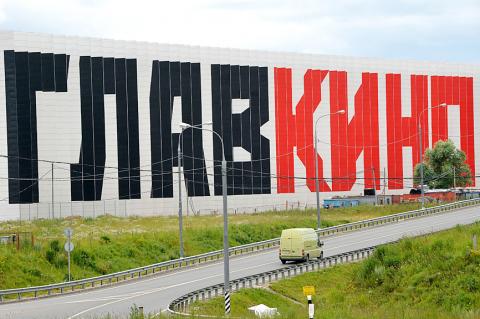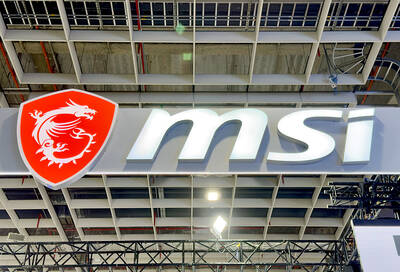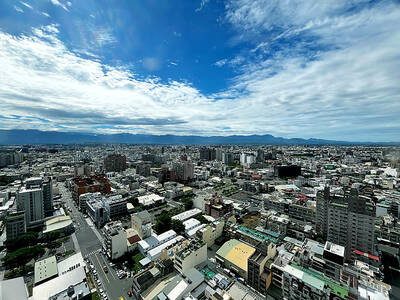A Russian company has spent US$89 million building eastern Europe’s largest production facilities in a field outside Moscow and hopes to lure Hollywood majors to shoot and produce movies.
The idea is to create a modern flagship studio that will make Russia a competitively priced destination for film projects and in turn modernize the local industry.
“It is one of the targets for us to invite international projects to get their experience, to get their technologies,” Glavkino grou general-director Ilya Bachurin said.

Photo: AFP
Opened by former Russian president Dmitry Medvedev in February, on a recent tour the Glavkino studios were still dusty from the construction process and smelled of paint.
Bachurin, 42, a former impresario and television executive, led the way through the studios to show off echoing sound stages and high-tech 3D equipment. The largest sound stage measures 3,108m2, a space so large that it swallowed up a bus parked in the corner.
“It is the biggest in eastern Europe,” Bachurin said. The studios have a Hollywood-style sign on the roof visible from passing planes. Their Web site boasts they are “equivalent to the best studios of America and Europe.”
So far one feature film has been completed at Glavkino: August 8, a strongly pro-Russian drama based on the 2008 Russia-Georgia war that was 90 percent funded by the Kremlin.
It aims to attract major global players to do studio shoots and post-production there and pass on their expertise to Russia’s technically lagging film industry.
“In fact we do not need their money — it’s not our major goal,” Bachurin said. “We need to attract their experience and their specialists: those who can make the studio a part of the big -international filmmaking industry.”
In June Glavkino gave British art-house director Peter Greenaway a voucher worth US$37,000 to spend on post-production for a planned remake of Death in Venice.
Greenaway told Hollywood Reporter he was considering Saint Petersburg as a location.
Without giving details, Bachurin said that Glavkino was planning to submit quotes for several big international projects.
One problem is that Russia offers no tax breaks for filmmakers. Add in a mass of headaches from tough rules on customs to visas and work permits.
“We are going to make special proposals, make prices lower,” Bachurin said.
“This is a pragmatic business. If it is convenient and profitable, people will be ready to do the math,” he said.
Viktor Ginzburg, a Russian-born film director based in the US was visiting the studios with a view to making his next film there — an adaptation of Viktor Pelevin’s novel Empire V.
He said he was impressed by the facilities.
“It seems terrific. They should dust it, though,” he added.
Yet he said the high-tech studios still lacked something: “film culture.”
“You need projection designers, art directors, set decorators, craftsmen,” he said. “Unfortunately there is a real problem in the Russian film industry right now with these key positions.”
That is a hangover from the 1990s when the film industry almost dried up and professions skipped an entire generation.
While Glavkino is new, it reeks of money and connections.
Its name uses Soviet-speak abbreviations: glav, or “main,” and kino, meaning “cinema” or “film,” to suggest the historic roots it lacks.
One co-founder with Bachurin is actor and director Fyodor Bondarchuk, 45, who made hit films including The 9th Company. His father Sergei Bondarchuk directed the Oscar-winning War and Peace.
Another co-owner is Konstantin Ernst, the director-general of state-controlled Channel One television, which also has a major filmmaking division.
The three men together with UralSib bank own 50 percent, while the other 50 percent belongs to private investor Vitaly Golovachev, according to Glavkino’s Web site.
The studio was built after the owners raised a massive loan from VTB bank. Glavkino could hardly be more different from what is still Russia’s main film studio, Mosfilm, a maze of buildings dating from the 1930s in a busy urban area hemmed in by construction.
“We do not feel it will be competition with Mosfilm, because the market for technical services is not filled, even now as we finish the Glavkino studios,” Bachurin said.
Currently, Glavkino is mainly being used to make television shows, while the plan is for the proportion to change to half-and-half.
A second stage upgrading the studios with equipment and everything from costume workshops to a five-star hotel will cost a further US$120 million and is expected to be finished by the end of next year.

Meta Platforms Inc offered US$100 million bonuses to OpenAI employees in an unsuccessful bid to poach the ChatGPT maker’s talent and strengthen its own generative artificial intelligence (AI) teams, OpenAI CEO Sam Altman has said. Facebook’s parent company — a competitor of OpenAI — also offered “giant” annual salaries exceeding US$100 million to OpenAI staffers, Altman said in an interview on the Uncapped with Jack Altman podcast released on Tuesday. “It is crazy,” Sam Altman told his brother Jack in the interview. “I’m really happy that at least so far none of our best people have decided to take them

BYPASSING CHINA TARIFFS: In the first five months of this year, Foxconn sent US$4.4bn of iPhones to the US from India, compared with US$3.7bn in the whole of last year Nearly all the iPhones exported by Foxconn Technology Group (富士康科技集團) from India went to the US between March and last month, customs data showed, far above last year’s average of 50 percent and a clear sign of Apple Inc’s efforts to bypass high US tariffs imposed on China. The numbers, being reported by Reuters for the first time, show that Apple has realigned its India exports to almost exclusively serve the US market, when previously the devices were more widely distributed to nations including the Netherlands and the Czech Republic. During March to last month, Foxconn, known as Hon Hai Precision Industry

PLANS: MSI is also planning to upgrade its service center in the Netherlands Micro-Star International Co (MSI, 微星) yesterday said it plans to set up a server assembly line at its Poland service center this year at the earliest. The computer and peripherals manufacturer expects that the new server assembly line would shorten transportation times in shipments to European countries, a company spokesperson told the Taipei Times by telephone. MSI manufactures motherboards, graphics cards, notebook computers, servers, optical storage devices and communication devices. The company operates plants in Taiwan and China, and runs a global network of service centers. The company is also considering upgrading its service center in the Netherlands into a

Taiwan’s property market is entering a freeze, with mortgage activity across the nation’s six largest cities plummeting in the first quarter, H&B Realty Co (住商不動產) said yesterday, citing mounting pressure on housing demand amid tighter lending rules and regulatory curbs. Mortgage applications in Taipei, New Taipei City, Taoyuan, Taichung, Tainan and Kaohsiung totaled 28,078 from January to March, a sharp 36.3 percent decline from 44,082 in the same period last year, the nation’s largest real-estate brokerage by franchise said, citing data from the Joint Credit Information Center (JCIC, 聯徵中心). “The simultaneous decline across all six cities reflects just how drastically the market